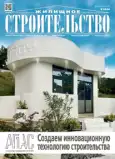3D construction printing as a tool for forming the design methodology of an actual modern object of architecture and construction
- Authors: Maltceva E.V.1
-
Affiliations:
- Federal State Budget Educational Institution of Higher Education «Industrial University of Tyumen» (IUT)
- Issue: No 8 (2024)
- Pages: 20-28
- Section: Articles
- URL: https://ter-arkhiv.ru/0044-4472/article/view/642637
- DOI: https://doi.org/10.31659/0044-4472-2024-8-20-28
- ID: 642637
Cite item
Abstract
An analysis of the experience of the design and construction of objects of modern architecture, reflecting in an aesthetic image, a high -tech direction and brightness of the image. In particular, the features of 3D construction printing with a variety of approaches and purposes of using this technology in the field of architecture are considered.The purpose of the research and analysis is to bring the theory of technological capabilities, their practical application and the relevance of modern architectural solutions into design methods, on the basis of which it is possible to form general trends and directions of aesthetic images of modern architecture.The article presents an approach to the design of a residential housing facility based on the analyzed experience and selected methods of architectural design, taking into account their subsequent implementation by 3D construction printing.
Full Text
About the authors
E. V. Maltceva
Federal State Budget Educational Institution of Higher Education «Industrial University of Tyumen» (IUT)
Author for correspondence.
Email: maltsevaev@tyuiu.ru
Junior Researcher, Laboratory of Additive Technologies in Construction
Russian Federation, 38, Volodarskogo Street, Tyumen, 625000References
- Kasyanov N.V. On the problem of the evolution of spatial forms of architecture in the context of scientific and technological achievements. Academia. Arkhitektura i stroitel’stvo. 2019. No. 3, pp. 34–43. (In Russian). https://doi.org/10.22337/2077-9038-2019-3-34-43
- Pustovgar A.P., Adamtsevich L.A., Adamtsevich A.O. International research experience in the field of additive construction production. Zhilishchnoe Stroitel’stvo [Housing Constructions]. 2023. No. 11, pp. 4–10. (In Russian). https://doi.org/10.31659/0044-4472-2023-11-4-10
- Barry Berman. 3-D printing: The new industrial revolution. Business Horizons. 2012. Vol. 55. Iss. 2, pp. 155–162. https://doi.org/10.1016/j.bushor.2011.11.003
- Slavcheva G.S. Analysis of the Russian regulatory documentation regulating the use and development of construction additive technologies. Stroitel’nye Мaterialy [Construction Materials]. 2023. No. 8, pp. 10–17. (In Russian). https:// doi.org/10.31659/0585-430X-2023-816-8-10-17
- Zasko V.V., Ratushnaya E.V. The use of 3D printers in construction. Resursosberegayushchie tekhnologii proizvodstva i obrabotki davleniem materialov v mashinostroenii. 2021. No. 4 (37), pp. 106–116. (In Russian).
- Simakova E.A., Selyakova K.I., Kravchenko D. An example of 3D packaging in construction. Inzhenernye issledovaniya. 2021. No. 1 (1), pp. 3–11(In Russian).
- Adamtsevich L.A., Ginzburg E.A., Shilov L.A. Construction 4.0. Zhilishchnoe Stroitel’stvo [Housing Constructions]. 2023. No. 11, pp. 18–23. (In Russian). https://doi.org/10.31659/0044-4472-2023-11-18-23
- Heijden J. Construction 4.0 in a narrow and broad sense: A systematic and comprehensive literature review. Building and Environment. 2023. Vol. 244, 110788. https://doi.org/10.1016/j.buildenv.2023.110788
- De Schutter G., Lesage K., Mechtcherine V., Nerella V.N., Habert G., Agusti-Juan I. Vision of 3D printing with concrete-technical, economic and environmental potentials. Cement and Concrete Research. 2018. Vol. 112, pp. 25–36. https://doi.org/10.1016/j.cemconres.2018.06.001
- Kamram M., Hussein A.B. 3D Printing concrete technology and mechanics from industrial aspect. Energy Policy. 2020. No. 3, pp. 2–12.
- Monastyrev P.V., Yezersky V.A., Ivanov I.A. Azaui Doubla B. Additive technologies for creating walls of low-rise buildings and their classification. Fundamental, survey and applied research of the Russian Academy of Architecture and Building Sciences on scientific support for the development of architecture, urban planning and the construction industry of the Russian Federation in 2018. Moscow: RAASN. 2018. Vol. 2, pp. 368–379.
- Razov I.O., Sokolov V.G., Dmitriev A.V., Erenchinov S.A. Proposal for the device of a cover during the introduction of a building using additive technologies. Stroitel’nye Мaterialy [Construction Materials]. 2023. No. 10, pp. 116–120. (In Russian). https:// doi.org/10.31659/0585-430X-2023-818-10-116-120
- Permyakov M.B., Krasnova T.V., Dorofeev A.V. Additive technologies in the construction and design architectural environment: present and future. Aktual’nye problemy sovremennoi nauki, tekhniki i obrazovaniya. 2018. Vol. 9. No. 2, pp. 2–5. (In Russian).
- Sokolov N.S. Technology of increasing a base bearing capacity. Stroitel’nye Materialy [Construction Materials]. 2019. No. 6, pp. 67–72. (In Russian). https://doi.org/10.31659/0585-430X-2019-771-6-67-71
- Slavcheva G.S., Akulova I.I., Vernigora I.V. The concept and effectiveness of the use of 3D packaging for the design of the urban environment. Zhilishchnoe Stroitel’stvo [Housing Constructions]. 2020. No. 3, pp. 49–55. (In Russian). https://doi.org/10.31659/0044-4472-2020-3-49-55
- Slavcheva G.S. Construction 3D furnace trinity: potential, problems and prospects of practical implementation. Stroitel’nye Мaterialy [Construction Materials]. 2021. No. 5, pp. 28–36. (In Russian). https://doi.org/10.31659/0585-430X-2021-791-5-28-36
Supplementary files




















